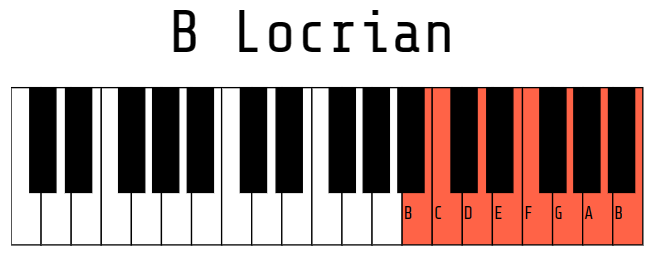Locrian scale (Locrian mode)
Locrian Mode Scale
The Locrian mode is a musical scale that is often associated with a diminished sound and has a unique characteristic: a lowered second, third, fifth, sixth, and seventh degree compared to the major scale.
The formula for the Locrian mode scale is: S - T - T - S - T - T - T
- Start on any note (tonic)
- Move up a half step (S)
- Move up a whole step (T)
- Move up a whole step (T)
- Move up a half step (S)
- Move up a whole step (T)
- Move up a whole step (T)
- Move up a whole step (T)
For example, if we start on the note B, applying the formula gives us the B Locrian mode scale:
- B - C - D - E - F - G - A - B
The Locrian mode is rarely used in traditional tonal music due to its unstable and unresolved quality. It is more commonly used as a theoretical concept and in certain avant-garde or experimental compositions.

Locrian Mode Characteristics
The Locrian mode is a unique scale that stands out due to its distinctive interval pattern and the particular mood it creates.
Here are a few key aspects that make the Locrian mode special and differentiate it from other scales:
- Diminished Quality: The Locrian mode is characterized by its diminished triad and diminished seventh chord, creating a dissonant and unresolved sound.
- Unstable Tonality: The Locrian mode lacks a stable tonic due to its lowered fifth and diminished tonal center, resulting in an unsettled and ambiguous quality.
- Avant-Garde and Experimental Music: The Locrian mode is often explored in avant-garde, experimental, or dissonant compositions that aim to push the boundaries of traditional tonality.
- Uncommon Usage: The Locrian mode is the least used and least familiar mode in traditional tonal music due to its challenging harmonic characteristics.
- Special Applications: Despite its rarity, the Locrian mode can be creatively employed in certain musical contexts, such as adding tension or dissonance to specific sections or chord progressions.
Overall, the Locrian mode's unique qualities make it an intriguing choice for composers and musicians exploring unconventional and dissonant musical territories.
Famous Songs in Locrian Mode
Due to its highly dissonant and unstable nature, the Locrian mode is rarely used in popular or mainstream music. Therefore, there are no well-known songs that exclusively utilize the Locrian mode.
However, the Locrian mode can be encountered in experimental, avant-garde, or highly complex compositions that explore dissonance and unconventional tonalities.
An example of song that uses locrian mode is: "Army Of Me" - Björk.
Keep in mind that the Locrian mode might be present in certain sections of these compositions or used as a basis for specific harmonic progressions, rather than being the entire composition.
Chords in B Locrian Mode
Triads:
- Bdim (B diminished): B - D - F
- C (C major): C - E - G
- Dm (D minor): D - F - A
- Em (E minor): E - G - B
- F (F major): F - A - C
- G (G major): G - B - D
- Am (A minor): A - C - E
Quadriads:
- Bm7b5 (B half-diminished 7): B - D - F - A
- Cmaj7 (C major 7): C - E - G - B
- Dm7 (D minor 7): D - F - A - C
- Em7 (E minor 7): E - G - B - D
- Fmaj7 (F major 7): F - A - C - E
- G7 (G dominant 7): G - B - D - F
- Am7 (A minor 7): A - C - E - G
These chords are derived by stacking thirds (either major or minor) on each degree of the B Locrian mode.